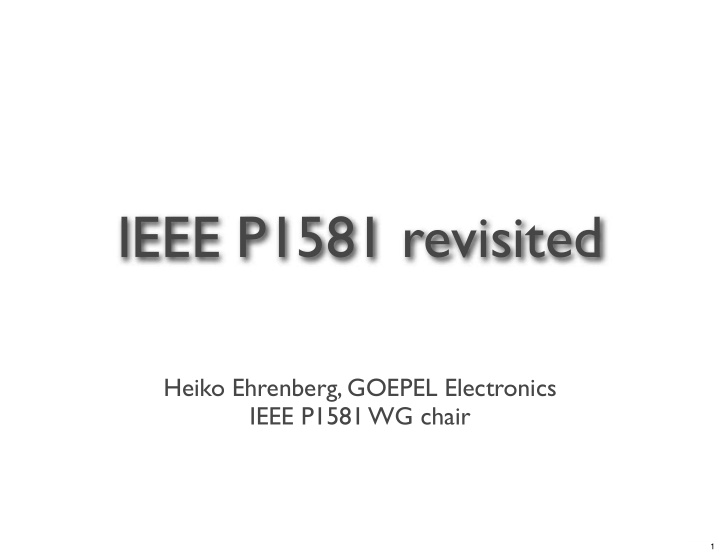



IEEE P1581 revisited Heiko Ehrenberg, GOEPEL Electronics IEEE P1581 WG chair 1
Objective • P1581 Emulation Board • Example Test Flow • Compare Test Methods Disclaimer: P1581 Working Group may or may not agree with content. P1581 Demo Board discussion and demonstration – Board Test Workshop 2008 2
P1581 – A quick review • Simple Test Logic Implementation for Memory Devices (and possibly other complex, slave-type components) • No extra pins required • Not relying on complex Memory Access Cycles • Fast test execution, small test vector set • Usable with any access methodology (BScan, functional, embedded, even ICT) P1581 Demo Board discussion and demonstration – Board Test Workshop 2008 3
P1581 Concept P1581 Demo Board discussion and demonstration – Board Test Workshop 2008 4
P1581 Concept P1581 Demo Board discussion and demonstration – Board Test Workshop 2008 5
P1581 Emulation Board BScan TAP XH500 XH301 for alternative access Memory XH302 to memory device pins Controller (FPGA) U500 XH303 Fault Simulation Switches S300 P1581 Emulator (FPGA) XH304 U202 Memory Module XH300 ISP TAP sEEPROM XH200 U200 P1581 Demo Board discussion and demonstration – Board Test Workshop 2008 6
P1581 Emulation Board Memory Controller (BScan Device) Memory Module Fault Switches (holding SRAM) P1581 Demo Board discussion and demonstration – Board Test Workshop 2008 7
P1581 sequence TMode A: OE* inactive, WE*, CE1*, CE2 and either BYTE* or both BLE* and BHE* simultaneously and continuously active for more than 150 µs TMode B: apply OE*, WE*, CE1*, and CE2 simultaneously Apply command (using address signals) and read 32 bit device ID (bit-wise or 8 bit word-wise) Apply stimulus pattern on address signals (inputs) and observe and evaluate response pattern on data signals (outputs), linked through P1581 test logic Apply command (using address signals) and toggle control signals N times, then read out counter values Apply command (using address signals) and execute optional test functions/algorithms (e.g. BIST, initialization, etc.) Test mode resets immediately with functional write access and with special command (A18 through A01 driven with a binary value of 111111000000111111, while A00 transitions from a logic zero to a logic 1) P1581 Demo Board discussion and demonstration – Board Test Workshop 2008 8
SRAM Results Number of Response Vectors SVF Test File Size [kByte] Number of DRShifts BScan Memory Access Test (with Diagnostics) BScan Memory Access Test (without Diagnostics) P1581 Continuity Test (with Diagnostics) {Less is better in all four graphs.} Test Time [s] P1581 Demo Board discussion and demonstration – Board Test Workshop 2008 T 9
In summary ... • Are there alternative methods for testing connections to memories? • Would you like to see P1581 become reality? ‣ http://grouper.ieee.org/groups/1581 P1581 Demo Board discussion and demonstration – Board Test Workshop 2008 10
Recommend
More recommend